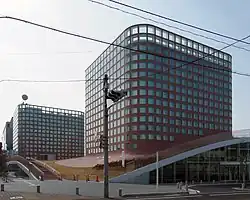Riken Yamamoto | |
|---|---|
.jpg.webp) | |
| Born | 1945 Beijing, China |
| Nationality | Japanese |
| Alma mater | Nihon University, Tokyo University of the Arts |
| Occupation | Architect |
| Awards | Architectural Institute of Japan Award |
Riken Yamamoto (山本理顕, Yamamoto Riken), born 1945 Beijing, China[1][2] is a Japanese architect.
Education
Yamamoto completed his bachelor's degree from Nihon University in 1967 and his master's degree from the Tokyo University of the Arts in 1971, after which he continued his studies at the University of Tokyo under Hiroshi Hara.
Career
He founded the Yamamoto & Field Shop Co.Ltd in 1973. Yamamoto was a professor at Yokohama National University from 2000 to 2011 and at the Graduate school of Engineering of the Nihon University. He currently teaches at his alma mater Nihon University.[1][2] Some of his most representative works are the Rotunda Building (Yokohama, 1981); the Hamlet Building (Tokio, Shibuya-Ku, 1988), or the apartment blocks Ryukoentoshi (Yokohama, 1992)
Recognition
Under the many awards Riken Yamamoto has won, the most recent achieved by him are: The Japan Institute of Architects Award for the Yokosuka Museum of Art (2010) Building Contractors Society Prize for the Namics Techno Core (2010), Building Contractors Society Prize for the Yokosuka Museum of Art (2008) or the 25th Fukushima Architecture Culture Award, highest award for the Fukushima ecoms Pavilion, SUS Fukushima Factory (2007).[3]
Selected works
- 1975: Mihira House, Kanagawa Prefecture
- 1977: Shindo House, Kanagawa Prefecture; Yamakawa Villa
- 1978: Kubota House, Tokyo, Yamamoto House; Kanagawa Prefecture, Studio Steps, Kanagawa Prefecture
- 1985: Omata House, Kanagawa Prefecture
- 1987: Daiko Dormitory, Kanagawa Prefecture; Marufuji (Kosaku store), Tokyo; ROTUNDA Kanagawa Prefecture
- 1988: Hamlet Tokyo; Fujii Gallery, Tokyo
- 1996: Iwadeyama Junior High School, Miyagi Prefecture
- 1999: Saitama Prefectural University; Saitama
- 2000: Hiroshima West Fire Station, Hiroshima
- 2001: Tokyo Wells Technical Center, Shizuoka;
- 2002: D Clinic, Saitama
- 2005: Future University Hakodate Research Building, Hokkaido; SUSTRG Office Project, Fukushima
- 2007: Yokosuka Museum of Art, Kanagawa Prefecture
- 2008: Namics Techno Core, Niigata; Guan Yuan Housing, Beijing; Dragon Lily's House, Gunma
- 2009: Utsunomiya University Center for Optics Research Tochigi
- 2012: Tianjin Library[4]
- 2018 (planned): The Circle at Zürich Airport[5][6]
 Hiroshima West Fire Department
Hiroshima West Fire Department Future University Hakodate
Future University Hakodate Yokosuka Museum of Art
Yokosuka Museum of Art Fussa City Hall
Fussa City Hall
References
- 1 2 "Riken Yamamoto". Barcelona Institute of Architecture. Retrieved 3 May 2015.
- 1 2 "「地域社会圏」という考え方". 東西アスファルト事業協同組合. Retrieved 3 May 2015.
- ↑ "Riken Yamamoto". www.mchmaster.com. Retrieved 2018-07-31.
- ↑ Li, Xinzhe (4 February 2015). "Yamamoto's Tianjin Library". MPTF. Retrieved 3 May 2015.
- ↑ "The Circle at Zurich Airport". thecircle.ch/. Archived from the original on 23 September 2015. Retrieved 18 June 2015.
- ↑ "Japanese architect wins Zürich Airport's 'The Circle' contest". Tages-Anzeiger. 2 November 2010. Archived from the original on 12 October 2015. Retrieved 12 October 2015.
External links
 Media related to Riken Yamamoto at Wikimedia Commons
Media related to Riken Yamamoto at Wikimedia Commons- Riken Yamamoto Official Website (in Japanese, English, and Chinese)
- Riken Yamamoto l'hospitalier Le Journal des Arts (in French)